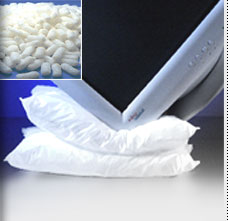
Background
There was a time no so long ago, when people would throw
food scraps, peelings and the like into the compos heap in
the back corner of their garden. The rest of the household
rubbish went into the dustbin in plastic sacks. Since those
days, things have changed. Now you can feed the compost heap
with the plastic sacks too. British company Symphony Environmental
is producing fully degradable bin bags, carrier bags and other
plastic bags from polyethylene, using new additive technology
to reduce the plastic to carbon dioxide and water in just
a few weeks.
Degradable Polyethylene
Symphony's material is the first example of 100% degradable
polyethylene. The plastic, known as SPITEK, has the same mechanical
properties and processing characteristics as regular polyethylene
and so can be used in the same way to make products. However,
it has a special ingredient - up to 3% of a degradable compostable
plastic (DCP) additive made under license from its developers
EPI. This additive acts as a catalyst for the degradation
of the polyethylene, kick starting the process when conditions
dictate.

The Need for a Fully Degradable Plastic
The need for a fully degradable plastic is pressing. Millions
of tonnes of plastic waste, including refuse sacks, carrier
bags and packaging, are buried in landfill sites around the
world each year. China generates about 16 million tonnes,
India 4.5 million tonnes and the UK 1 million tonnes, of which
more than 800,000 tonnes is waste polyethylene. Other disposal
routes are possible for these materials, such as recycling
and incineration, but as much of the waste plastic is mixed
up with other materials in the domestic and industrial waste
streams, separation is costly particularly for small items
such as carrier bags.
Conventional Polyethylene
Conventional polyethylene products can take longer than 100
years to degrade, taking up valuable landfill space and potentially
preventing the breakdown of biodegradable materials contained,
say, in a refuse sack.
Effect on Landfill Sites
Symphony claims that its new plastic could effectively increase
the capacity of landfill sites by as much as 20 to 30% by
breaking down in a short time and allowing other materials
to degrade.
Degradation Properties
The SPI-TEK material can be engineered to degrade in as little
as 60 days or as long as 5 to 6 years, depending on the application.
The level of the proprietary EPI DCP additive effectively
determines the rate of degradation and the shelf life of products
made from the polyethylene. Degradation is initiated by a
number of factors - sunlight, heat and stress from pulling
and tearing can all start the process, which then continues
even if the material is in landfill or under water.

How the Degradation Process Works
The catalyst causes carbon-carbon bonds in the polyethylene
backbone to be broken, reducing the molecular weight and durability
of the material. Tests have shown a reduction in molecular
weight from a quarter of a million to less than 4,000, at
which point the material can be digested by microorganisms
in the soil and water. The final products of the degradation
process are simply carbon dioxide and water. The DCP additive
is neither water soluble nor toxic, making the material safe
for disposal in landfill sites such as the flushing bio-reactor
systems that are widely used in the UK. These systems introduce
pressurised water flows into the layers of waste material,
feeding oxygen and microorganisms down to the degrading rubbish.
The material will also degrade under other conditions, not
just in the composting-type conditions of a landfill site.
Figure 1 shows the effect of photo and thermal degradation
on a carrier bag made from the new polyethylene compared to
standard plastic, The bag degrades to mulch in just 55 days.
Extensive tests such as this one and tests on buried material
were carried out on the new polyethylene to prove its degradability,
including testing with Pira International.
Applications
Symphony intends to launch a wide range of products made
from its new polyethylene, including everything from small
produce bags and carrier bags to larger packaging items and
products such as degradable plastic aprons for children. The
possibilities are great for the new material because it has
the same performance as conventional polyethylene and yet
doesn't have any cost restrictions on its use. Refuse sacks
are already on the market under the Tuffy brand name, promoting
the material's environmental credentials. The bags come with
a list of ‘do’s and 'don’ts’ on the label
advising users how to store the bags and so prevent premature
degradation. Apart from that, they are exactly the same as
any other refuse sacks.
Biodegradable Polyester Amide
Of course, Symphony Environmental is not the only company
producing new materials that could end their lives on the
compost heap. Bayer is currently testing a new polyester amide
biodegradable plastic that it claims is 100% biodegradable
and recyclable, and yet also has excellent properties including
a high tensile strength. The plastic has additional green
credentials as it is produced without solvents, chlorine or
any aromatic ingredients.
BAK 1095 is a semi-crystalline, largely transparent thermoplastic
that breaks down into carbon dioxide, water and biomass under
composting conditions. Its degradation rate is comparable
to that of other organic materials that are composted, and
yet its physical properties are similar to those of typical
polyolefins such as LDPE. Bayer says that the plastic is suitable
for a number of processes, such as film blowing, extrusion,
thermoforming, spinning, injection moulding, blow moulding,
colouring, printing, hot sealing and welding. It suggests
that potential applications will be in areas such as horticulture,
agriculture or the food sector, in which plastics must be
used in conjunction with compostable waste.

|

